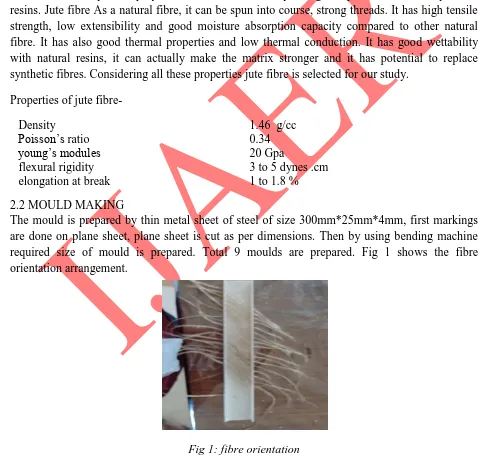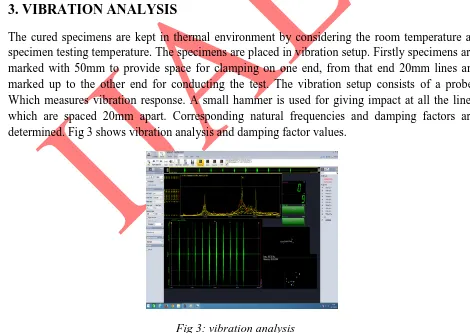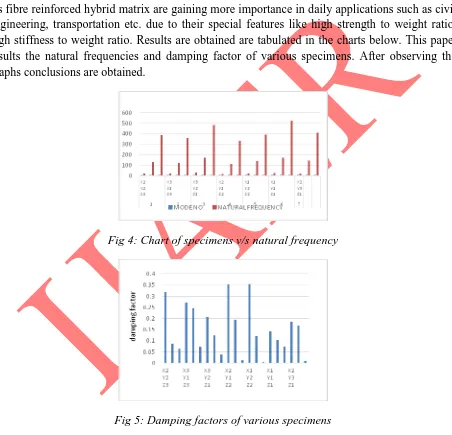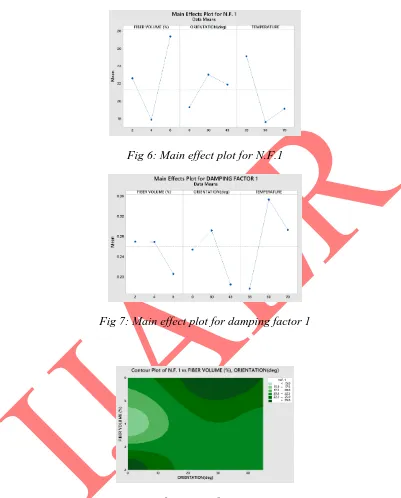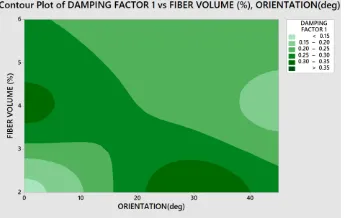THERMAL BUCKLING ANALYSIS OF JUTE
REINFORCED HYBRID POLYMER MATRIX
COMPOSITE
Chinmay Bhalchandra Tagare, Rohit Patil, Prasann P. Yadav,G. Venkatachalam.
School of Mechanical and Building Science, VIT University, Vellore-632014, Tamilnadu, India.
ABSTRACT
The interest in using natural fibres as reinforcement in polymers are increased significantly during these last few years. Natural fibres are not only strong, lightweight, but also cheap and degradable. In this work, investigation is carried out on jute fibre reinforced hybrid polymer composite. This work describes the vibrational behaviour of prepared composite consists of jute as reinforcement in thermal environment. The composites are manufactured as hand lay-up technique. Three parameters- curing temperature, fibre volume fraction and fibre orientation are varied. Then 9 samples are selected using TAGUCHI design of experiment technique. Thermal environment is provided by using hot air oven. By applying buckling load, the behaviour and mechanical properties of specimens are analysed using ANOVA technique.
KEYWORDS- hybrid polymer, jute
1. INTRODUCTION
108
2. EXPERIMENT
2.1MATERIALS
CNSL
It is phenol based petroleum product. Naturally occurring CNSL contain four components cardanol, cardol, anacardic acid and 2 methyl cardol. It is extracted from honey combed shell of cashew nut. It is of brown colour. Because of its biodegradability, low cost and easy availability. It has become important polymer matrix and it has impending competitiveness with synthetic resins. Jute fibre As a natural fibre, it can be spun into course, strong threads. It has high tensile strength, low extensibility and good moisture absorption capacity compared to other natural fibre. It has also good thermal properties and low thermal conduction. It has good wettability with natural resins, it can actually make the matrix stronger and it has potential to replace synthetic fibres. Considering all these properties jute fibre is selected for our study.
Properties of jute fibre-
Density 1.46 g/cc
Poisson’s ratio 0.34
young’s modules 20 Gpa
flexural rigidity 3 to 5 dynes .cm
elongation at break 1 to 1.8 %
2.2 MOULD MAKING
The mould is prepared by thin metal sheet of steel of size 300mm*25mm*4mm, first markings are done on plane sheet, plane sheet is cut as per dimensions. Then by using bending machine
required size of mould is prepared. Total 9 moulds are prepared. Fig 1 shows the fibre orientation arrangement.
2.3 SPECIMENMAKING
The preparation of moulds,9specimens are selected according to TAGUCHI method by taking 3parameters. X-fibre Volume, Y-fibre orientation, Z- curing temperature. Firstly, the volume of specimen is calculated. Then by considering the fiber volume, we determined the length of fiber based on the length, the number of fibers are calculated. Then according to that slots are made on mould by using hex blade. Then fibers are fixed by using clay in the respective slots. The clay is fixed at both the end. Wax is used at inner side of mould so that they can easily come out after preparation. Fig 2 shows specimen preparation.
Fig2: Specimen preparation
Specimen No
X Y Z
1 2% 00 R.T
2 2% 300 500
3 2% 450 700
4 4% 00 500
5 4% 300 700
6 4% 450 R.T
7 6% 00 700
8 6% 300 R.T
110
The mixture is prepared by using following materials. (Here CNSL volume is kept fixed for all specimens.) Table 1 shows selected specimen by TAGUCHI technique. CNSL-7.5ml (15%), GPresin-42.5ml, catalyst-3-4drops, hardener-3-4drops. By considering above composition mixture is prepared and poured into moulds. Specimens 2, 3, 4,5,7,9 are kept in oven for curing at their respective temperatures. After curing of all the samples. Samples were removed from the moulds.
Fig 4: prepared specimens
3. VIBRATION ANALYSIS
The cured specimens are kept in thermal environment by considering the room temperature as specimen testing temperature. The specimens are placed in vibration setup. Firstly specimens are marked with 50mm to provide space for clamping on one end, from that end 20mm lines are marked up to the other end for conducting the test. The vibration setup consists of a probe. Which measures vibration response. A small hammer is used for giving impact at all the lines which are spaced 20mm apart. Corresponding natural frequencies and damping factors are determined. Fig 3 shows vibration analysis and damping factor values.
3.0 RESULTS AND DISCUSSIONS
To obtain the dynamic behaviour of composite, vibration analysis plays important role. From the mode shapes natural frequencies and damping factor of composite is obtained. Composite materials are often exposed to complex environment so vibration behaviour is having more importance.
As fibre reinforced hybrid matrix are gaining more importance in daily applications such as civil engineering, transportation etc. due to their special features like high strength to weight ratio, high stiffness to weight ratio. Results are obtained are tabulated in the charts below. This paper results the natural frequencies and damping factor of various specimens. After observing the graphs conclusions are obtained.
Fig 4: Chart of specimens v/s natural frequency
112 Fig 6: Main effect plot for N.F.1
Fig 7: Main effect plot for damping factor 1
Fig 9: Contour plot of damping factor vs fibre volume and orientation
Regression equation:
N.F. 1 = 29.5 - 0.29 FIBER VOLUME (%) + 0.056 ORIENTATION(deg)
0.168 TEMPERATURE
4. CONCLUSION
In this study the fiber matrix composites are prepared by varying fiber volume percentage, varying the curing temperature at different fiber orientations. After doing vibration analysis as per the procedure, by using ANNOVA analysis fig 6 and 7 shows main effect plots. And Fig 8 and 9 shows respective contour plots
As the curing temperature increases natural frequency decreases.
As the fibre orientation (00-450)increases natural frequency decreases.
5. REFERENCES
1)Thi-Thu-Loan Doan, Shang-Lin Gao, Edith Mader, Jute/polypropylene composites I- Effect of martia modification, composites Science and Technology, 66(2006), 952-963
2) Rana AK, Mandal A, Mitra BC, Jacobson R, Rowell R, Banerjee AN. Short Jute fibre reinforced polypropelene composites : effect of compatibiliser, J Appl Polymer Science 1998; 69; 329-389.
